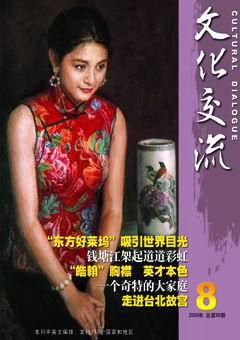History and Culture in Palace Museum in Taipei
Zhou Jun


I started a 10-day journey to visit Taiwan with a tour group of Shanghai residents on July 4, 2008. We toured around the island and our first impressions of the province could be summarized as if, just as described in an ancient poem, we were visiting our old friends after a long separation. For me, the best memory of the tour was the visit to the National Palace Museum in Taipei.
History
The National Palace Museum in Taipei was founded in August, 1965 and it is now home to over 650,000 pieces of the extremely precious treasures that partly define Chinese history and culture. My heart pumped as I approached the magnificent building against the emerald hills and pine woods and saw the yellow wall and green glaze-tiled roof shine in the sunlight. Many of us know that many of what we see at the Palace Museum in Beijing are merely leftovers after the selection in the 1930s.
The treasures in the collection of the museum in Taipei are the witness to the hardships China suffered in the 20th century. After the northeast China fell to the Japanese in 1931, the palace museum in Beijing started preparing to move its treasures to the safer inlands. After preparations of a year, 19,557 cases of treasures of the Palace Museum started their southward journey by train on the evening of February 5, 1933. Part of the collection stayed in Nanjing and the majority reached Shanghai. The Nanjing branch of the Palace Museum came into being four years later and all the cases were stored in the new museum. After the July 7 Incident and the fall of Shanghai in 1937, the treasures began moving again. Their density was Sichuan Province. The transportation of the priceless things was full of dangers and risks. Fortunately they finally reached Sichuan safely. After World War II, the treasures were shipped to Chongqing first and then began their move to Nanjing. After the civil war broke out in the late 1940s, the national government shipped part of the treasures to Taiwan from the Xinjin Airport 30 km out of Chengdu and the Xiaguan port in Nanjing respectively.
The collection was housed in a few different places after it reached Taiwan. It was not until November 12, 1965 that it was finally housed at the newly completed national palace museum. Since then, there have been two national palace museums in China on either side of the strait.
Collection
The KMT government did not have time to ship all the 19,557 cases of the royal house treasures to Taiwan when it faced rapid defeat in the Civil War (1946-1949). In the end, only 5,522 cases were shipped including 2,972 cases from the palace museum, accounting for about one quarter of the total artifacts in Beiping (the predecessor of todays Beijing). However, what the KMT got was the cream, including the royal collection, unearthed artifacts from the Yin Ruins at Anyang, ancient books of the Song (960-1279) and Yuan (1271-1368) dynasties in the collection of the Central Library, and a large quantity of precious artifacts stored at the preparatory office of the Central Museum. Also shipped to Taiwan were 60 cases of diplomatic documents and original copies of Chinas international treaties.
The second batch amounted to 3,502 cases. The treasures included the Complete Works of Chinese Classics in Four Divisions, made in the 47th year of the reign of Emperor Qianlong. The batch also included the best chinaware in the royal collection for about 1,000 years. Also in the second batch was the complete archive of the history of Manchuria which was written in the Manchurian language and first accumulated six years after the language was invented. It was the authentic history of the minority people before they founded the Qing Dynasty.
What We Saw There
Most of us in the group went there to see the best Chinaware made in the Ru Kilns, which manufactured the best celadon of the Song Dynasty (960-1279). The historical record of the Song Dynasty says that the best celadon features delicate body, delicate patterns and glazes in light blue, sky blue and light greenish blue. Of the 65 celadon pieces existing in the world that were made in the Ru Kilns, the Taipei National Palace Museum has 23, the Beijing Palace Museum has 17, Shanghai Museum has 8 and Percival David Foundation of Chinese Art has 7.
What I saw of the exhibits of Ru Kilns there gave me an education on how our ancestors defined the color blue and why Chinaware made in Ru Kilns was the best.
The most popular exhibit in the Taipei National Palace Museum is the Jadeite Cabbage with Insects. There are many who come to Taiwan just to take a look at the valued jade artifact. It was originally kept in the Yonghe Palace, the residence of a concubine of the Qing Dynasty. The piece was carved out of naturally occurring white and green parts of a piece of jadeite. The parts were transformed ingeniously into the lively forms of the leaves and stalks of a cabbage with a katydid and a locust lingering on the leaves. At that time, the cabbage was a metaphor for purity, symbolizing the purity of the bride. The insects, known for their ability to reproduce, were symbolic of fertility, a blessing for the newly wed lady to have many sons.
The artifacts from the Forbidden City are Chinese treasures. Although many experienced the wars and long journeys and many are in Taiwan now, fortunately they have survived. Today, the best Chinese antiques are respectively in the collections of the National Palace Museum in Taipei and the National Palace Museum in Beijing. We look forward to a day when the best in the two collections will be exhibited together.□

